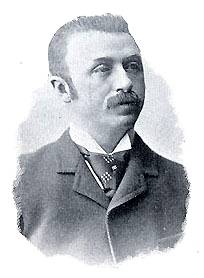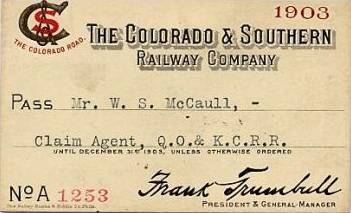Frank TrumbullThe man who ran the railroads the right way.
Nathan Franklin Trumbull was born 11 November 1858 at Arcadia, Missouri, the son of Walter Bowdoin Trumbull and Ann Mildred Thomas. His father was an educator. The family moved to DeSoto, Missouri, in 1860 and to Pleasant Hill in the fall of 1865. Frank received his education in the schools of Pleasant Hill, where his father was professor and superintendent. He went to work at the age of 12, becoming a clerk in the village bookstore. Two years later he became a clerk in the Pleasant Hill Post Office. On 1 October 1874, at the ripe old age of almost 16, Frank started his railway career as a clerk in the Controllers Office of the Missouri-Kansas-Texas Railroad at Sedalia, Missouri. During the next six years he served in every area department of the Controllers office and as traveling auditor, becoming chief clerk of the office. On 1 December 1880, the Missouri-Kansas-Texas became part of the Missouri Pacific, and a year later Frank was appointed chief clerk of freight accounts in the Office of Auditor of the Missouri Pacific at St. Louis. After three years, he became freight claim agent for the system. Frank married Cora Hale at Sedalia, Missouri, in 1881. They had one child, born in 1882. Cora died in 1889. On 1 January 1886, Frank was appointed head of the auditing department of the Texas & Pacific Railroad, which was in receivership at the time. He moved to Dallas, Texas, and served in this position until the road was reorganized 30 June 1888. Frank married Mary Sisson in 1891 at Dallas. She died in 1916. Upon leaving the Texas & Pacific, Frank moved to Denver, Colorado, where he engaged in the wholesale coal business. During this time he was employed by New York and London bankers to report on railroad and other properties. On 13 October 1893, following a spring stock market crash and carrying a massive load of debt ($473 million -- equivalent to slightly over $9 billion today), the mighty Union Pacific was declared bankrupt and its property placed in the hands of three Receivers. This indirectly included the Union Pacific Denver & Gulf and the Denver Leadville & Gunnison railroads, two narrow gauge lines operating out of Denver. Former Colorado Governor John Evans, a prominent stockholder, petitioned the Court and—despite opposition from the Union Pacific—was successful in having a separate local Receiver appointed for the Union Pacific Denver & Gulf: businessman Frank Trumbull. In August of the following year, parties interested in the Denver Leadville & Gunnison were successful in having it also placed into the hands of the same local Receiver. Thus at age 35, Frank Trumbull became Receiver and General Manager of two bankrupt mountain railroads, which he thereafter operated as if they were one, to the benefit of both. But though virtually all historians of these railroads agree that Frank brought new, “enlightened,” skillful management to these roads, times and conditions were such that he was not able to bring the two lines out of bankruptcy, and 18 November 1898 the assets of the Denver Leadville & Gunnison were sold to representatives of its bondholders at foreclosure, and the next day, the assets of the Union Pacific Denver & Gulf were sold to representatives of its bondholders at foreclosure. A new corporation—the Colorado & Southern Railway Company, capitalized at $48 million (equivalent to almost $1 billion today)—was chartered 19 December. It took control of the assets of the two railroads, with some 1,085.1 miles of track, at midnight 11 January 1899. Frank Trumbull was appointed its President and General Manager.
On 2 July 1900, the Colorado & Southern and the Rio Grande Western (under the control of the Denver & Rio Grande) acquired control of the Colorado Midland Railroad, and Frank also became President of that line, which was to remain an independent railroad. Under his direction the Midland obtained new traffic sources and made physical improvements that would permit more efficient and economical operation. By 1902, the Colorado & Southern was doing so well that a controlling interest was bought by a syndicate headed by Edwin Hawley, then president of the Minneapolis & St. Louis and the Iowa Central railroads. Knowing a good man when he saw him, Hawley kept Frank in charge. In January 1905 the Colorado & Southern gained control of the Colorado Springs & Cripple Creek District Railway, and Frank became President of that line also. Later that year he moved to New York City. Toward the end of the year, the Colorado & Southern advanced money on the construction bonds of the Wichita Valley Railroad Company, and Frank became a member of that Board of Directors. (This apparently related to the Fort Worth & Denver City Railway Company, as on 13 June 1952 the Wichita Valley Railroad became part of the Fort Worth & Denver City Railroad. And yes, that date is correct: nineteen fifty-two!) In December 1908, the Colorado & Southern Railway was purchased by the
Chicago, Burlington & Quincy Railroad. The Colorado Midland and, for that matter, the
narrow gauge South Park Division of the Colorado & Southern, came along with the deal. Frank—who
by now was a valuable man to the Hawley interests—shortly resigned his position. In 1911, Frank became a trustee of the Union Trust Company of New York. In November of 1912 he was elected a member of the Board of Directors of the National City Bank of New York. In 1913, he became a Director of the Union Pacific System. He resigned the National City Bank position in 1915 and from the Union Pacific System in 1916.
In 1917, in addition to being Chairman of the Board of Directors of the C&O, Frank was also Chairman of the Board of Directors of Hocking Valley Railway Company and of the Missouri Kansas Texas Railway Company, a member of the Board of Directors of the National City Bank of New York, Chairman of the Railway Executives' Advisory Committee, Chairman of the Immigration Committee of the Chamber of Commerce of the United States, Chairman of the National Americanization Committee, a member of the Chamber of Commerce of the State of New York and a member of the Advisory Committee of the Commission for Relief in Belgium. He was a member of the Metropolitan Club of New York, and of the Sleepy Hollow Country Club, of the City Midday, of the Recess and Economic Clubs of New York, of the New England Society, of the Society of Colonial Wars and of the Automobile Club of America. He was a Trustee of Tuskegee, Alabama, Normal and Industrial Institute and also of Colorado College, and a member of the Board of Managers of the New York Society for the Relief of the Ruptured and the Crippled, also a member of Broadway Tabernacle (Congregational) Church. Frank Trumbull died in 1920 at age 62. At his death he was a Director of several railroads, and Chairman of the Board of the Missouri-Kansas-Texas Railroad.
|
|||||||||



